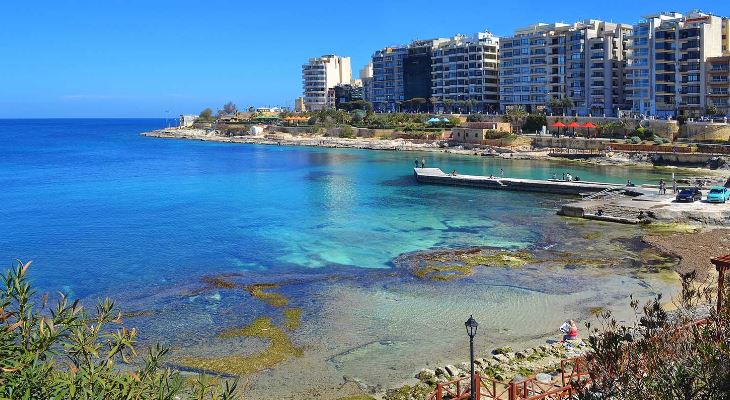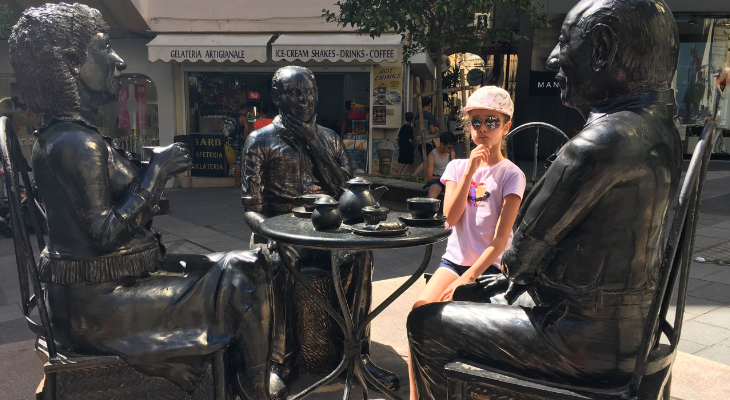There’s more to this popular residential and commercial town than high-rise apartments, shopping and cafes, although those are good too!

K B / flickr
I’ve been lucky enough to call Sliema home for the past 25 years or so. I’ve seen it change dramatically in the meantime, perhaps not entirely for the better, as gracious seafront houses with elegant bay windows have made way for apartment blocks of questionable design.
But, despite the changing landscape accompanied by a steep increase in the number of residents and their cars (with the inevitable parking issues), the heart of Sliema’s character remains true and strong. And there is surprisingly quite a lot to discover in this bustling town.
The promenade
One of Sliema’s defining features, the seaside promenade is a year-round attraction for everyone and not just local residents. For as long as I can remember, a walk on 'the front' was a real highlight, especially in summer when it would be packed every evening with, seemingly, half the island, till the small hours. Now, I must define 'walk'. We’re not talking about exercise here. The walk or passegiata is a purely idle pastime, a relaxed amble at a leisurely pace to see and be seen, to admire the beautiful sea views and the beautiful people, without breaking a sweat.
Of course, if you are interested in using the front for some more vigorous exercise, you can technically run/walk all the way from St Julian’s through Sliema, Gzira, Msida, Pieta’ and then on to Valletta along an almost continuous seaside promenade. You can also use the outdoor 'gym' near the watchtower. My children's favourite bit of the promenade is, of course, the playground at Qui-si-Sana, which is split into different areas targeted at different age groups. Another play area for the little people is nearer Balluta Bay, watched over by a rather eccentric giant cat with one eye (?!) and a third playground is situated right next to the watchtower.
Historic churches
Sliema has no fewer than four parish churches to cater for its ever growing population, but Stella Maris (Our Lady Star of the Sea) is the 'mother' parish, having been the first one to be established in 1855. Long before it grew into a busy town, Sliema was a fishing hamlet and a tiny chapel at Tigne point served as a beacon for sailors who would hail Our Lady as they sailed past, thus giving the name to the locality (“Sliem ghalik Marija” are the first words of the Hail Mary prayer in Maltese), or so the story goes. That chapel was desecrated by the French in the late 18th century. As Sliema grew, a bigger chapel dedicated to Our Lady of Graces was built in the early 19th century which still stands today opposite Stella Maris parish on High Street. The other churches are Sacro Cuor (Our Lady of the Sacred Heart) on St Trophimus Street, St Gregory on Norfolk Street and Jesus of Nazareth at the Ferries.
Architecture from the good old days
Progress hasn’t completely obliterated Sliema’s architectural charm, yet. Turn your back on the promenade and walk up the side streets to catch a glimpse of the real Sliema, with its rows of townhouses adorned with colourful wooden balconies and the odd palatial house - a relic of days gone by, when the town was populated by affluent families. Sliema was always considered an upmarket and desirable place to live, and that has not changed much over the years, with property prices always remaining high. One of the houses that survived the onslaught of development is an elegant villa dating from 1914 at the bottom of Dingli Street, now beautifully restored and turned into a bank.
Check out the unusual Moorish houses on Rudolph Street designed by Emanuele Galizia in the late 19th century. The striking oriental houses are unique in Malta. As Chief Architect of Malta under the British, Galizia also built the Turkish cemetery at Marsa funded by the Sultan of Turkey. The two single-floor houses on Rudolph Street, called Alcazar and Alhambra, were originally meant as a summer residence for the architect and as a home for celebrated local artist Giuseppe Cali. There is also a third house, Pax, which is two floors high with a wooden balcony with Persian blinds covering the windows.
Another unusual house is the neo-gothic property with a crenellated roof that was once the home of former Prime Minister of Malta Gorg Borg Olivier, on the street named after him. It is located next door to the 200-year old Palazzo Capua, one of Sliema’s oldest and finest landmark properties - now a meetings and events venue with five accommodation suites named after the palace’s previous owners. And don’t miss one of the most iconic edifices of the town, the art-deco Balluta Buildings constructed in 1927 in Balluta Bay.
Keeping Sliema secure
As a coastal area, Sliema always needed to be well defended. Sliema has its own 17th century watchtower which gave the name to Tower Road running along the promenade. The tower is part of a coastal defence system developed by the Knights of St John which were manned nightly to look out for any seaward approaches and to raise the alarm of any imminent attack. The towers were built within sighting distance of each other, so that a fire signal lit in one post could be spotted by the neighbouring tower, and the message carried on around the island in this manner. The next tower along from Sliema is now in the grounds of the Corinthia San Gorg Hotel across the bay. Today, Sliema’s tower is a popular bar and restaurant.
The town also has an artillery battery right on the famous promenade. The battery, known by locals as il-Fortizza, was constructed by the British in 1872 and its searchlight was used to expose the position of enemy ships as they approached Grand Harbour. Today it too is a popular eatery.
The beach
There are no sandy beaches in Sliema, but the rocky shore is still a very popular bathing spot. Exiles beach (which gets its name from the number of Russian emigrés who arrived in Malta after the 1917 Bolshevik revolution) underneath the watchtower is a perennial favourite with locals, many of whom would spend their entire summer hanging out and socialising there. Another popular stretch of rocky beach is by the Surfside restaurant which even has a coastguard with a first aid clinic and showers. Do watch out for the signal flags, as the sea can get pretty rough there. You will notice mini swimming pools hewn out of the rocks along the shoreline. These 'baths' were once reserved for the wealthy and privileged few, and some were even enclosed with wooden fences to ensure privacy. Locals also flock to the two waterpolo pitches in the area, which in summer double up as beach lidos.
Join three actors for tea

Adriana Bishop
At the bottom of Bisazza Street is a glass ceramic monument dedicated to Maltese artists featuring three of Malta’s most beloved actors Gemma Portelli (1932 - 2008), Charles Clews (1919 - 2009) and Victor Apap (1913 - 2001). The three actors are sitting at a table having a cup of tea and clearly having a great time. A fourth seat is left free for you to join them.
Of ferries and folk songs
(A ferry is coming and another is leaving, from Sliema to Marsamxett. The master, with a pipe in his mouth, directing the vessel. In the middle of the harbour the captain felt sick and had no one to assist him. He was assisted by the sailors. Prepare the papers, prepare the papers, prepare the papers to send him to a home for the elderly.)
Up till World War II Sliema operated a regular ferry service across Marsamxett Harbour to Valletta with boats carrying up to 80 passengers each trip. In the days when public transport consisted of little more than a horse-drawn carriage (karozzin) this was the quickest way to cross over to Valletta. The ferry service inspired a children’s song which is still known to this day. Most masters (helmsmen or captain) enjoyed the song and would respond with a long blow on the horn. The ferry service stopped in 1959, but was revived in 1991 more as a means to beat the traffic to the capital.
Graffiti art with a message
Take a blank wall overlooking a dusty, makeshift car park and give it to a creative hand and you’ll be left with an eye-catching clever piece of graffiti art that has already achieved iconic status. Created by artist MTO, the four-storey high mural of a man scrambling through a wall has a companion piece in the South of Italy, for that same man emerges on the side of a building in the town of Sapri. The artwork, entitled 'Mediterranean Door' represents the struggle of migrants who leave Southern shores and head to Northern Europe in search of a better life.
Café life
If you just want to indulge in a spot of people watching while sipping a proper coffee or a cool cocktail, you’ll be spoilt for choice in Sliema. Malta’s proximity to Sicily has seen a number of gelaterias and dolcerias opening here, selling a delectable array of Italian delights. The promenade is also dotted with bars and restaurants (including my personal favourite Il-Gabbana, in reference to the fact that it is little more than a glorified kiosk attached to the bus stop).
Shop till you drop
Ultimately, Sliema is Malta’s prime shopping destination, with some of the best international high street brands along the Ferries, Tower Road and Bisazza Street, not to mention two shopping malls, Plaza Shopping Centre on Bisazza Street and Tigne Point. And of course, as history is never far away, Tigne Point incorporates some of the original architectural features of the military barracks which previously stood there. It also includes Tigne Fort built by the Knights of St John between 1793 and 1795 to protect the entrance to Marsamxett Harbour.